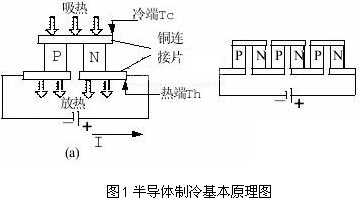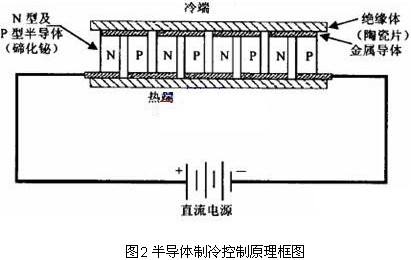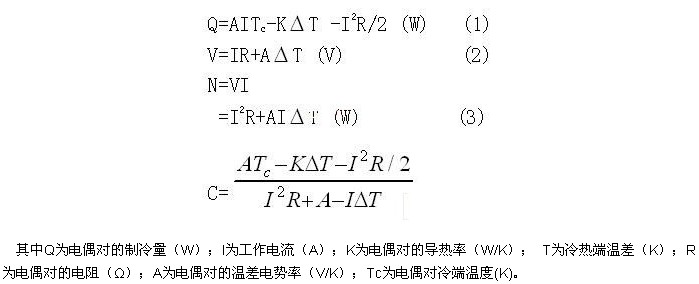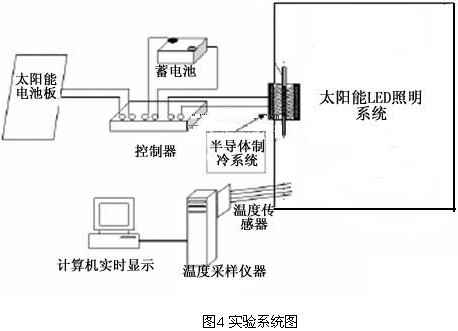In today's world's energy shortage and increasingly serious environmental pollution, the full development and utilization of solar energy is one of the energy strategies actively implemented by governments around the world. The application of solar LED lighting systems is in line with the development trend of this strategic decision. However, the development of LED lighting systems has been largely affected by thermal issues.
For LED lighting systems, LEDs can only convert a small amount of electrical energy into light energy during operation, and most of the energy is converted into heat. As the power of the LED increases, the amount of heat is increased. If the heat dissipation problem is not solved well, the heat is concentrated in the chip having a small size, so that the internal temperature of the chip is getting higher and higher. When the temperature rises, it will cause the following effects [1]: (1) the working voltage is reduced; the light intensity is reduced; the wavelength of the light is longer. (2) Reduce the efficiency of the LED driver, damage the life of the magnetic component and the output capacitor, and reduce the reliability of the LED driver. (3) Reduce the life of the LED and accelerate the light decay of the LED. The heat dissipation problem of LED lighting systems has become a major obstacle to the development of this technology. At present, the main methods used in solving the heat dissipation problem of the LED lighting system are: adjusting the spacing of the LEDs; reasonably increasing the distance between the LED and the metal core printed board; punching mode; installing a fan. These methods are affected by many objective conditions in practical applications, and the heat dissipation effect is not very satisfactory.
Semiconductor refrigeration, also known as thermoelectric refrigeration [2], is the use of the Peltier effect of semiconductor materials. When the direct current is passed through a galvanic couple of two different semiconductor materials in series, heat can be absorbed and heat can be released at both ends of the galvanic couple, and the purpose of cooling can be achieved. It is a refrigeration technology that produces negative thermal resistance, which is characterized by no moving parts and high reliability. The use of semiconductor refrigeration to solve the heat dissipation problem of LED lighting systems has high practical value.
1. The working principle of semiconductor refrigeration
In 1934, the Frenchman Peltier discovered that when the current flows through the junction formed by two different conductors, it will generate exothermic and endothermic phenomena. The exotherm or endotherm is determined by the magnitude of the current.
Q=aTI
In the above formula: Q is exothermic or endothermic power; a is temperature difference electromotive force rate; T is cold junction temperature; I is working current.
Based on the Peltier effect principle, Peltier effect cooling is also called temperature difference cooling. The main principle of semiconductor refrigeration technology is based on the Peltier effect. Semiconductor refrigeration is based on the characteristics of thermoelectric effect technology. It uses special semiconductor material thermopile to cool, which can convert electric energy directly into heat energy with high efficiency. At present, the semiconductor materials used in refrigerators are mainly bismuth telluride [3]. The addition of impurities is specially treated to form N-type or P-type semiconductor temperature difference components. Its working characteristic is that one side of the cooling side is heated.
According to quantum theory, metal and semiconductor materials have different energy levels, different contact potential differences, and different load bodies. As shown in Figure 1, the P-type and N-type semiconductors are connected by a metal plate, and the other end is formed by a metal plate to form a circuit in the figure. When the electric key k is closed, the current in the figure passes through the PN junction, and thus The Peltier cooling effect is formed at the upper end of the semiconductor and the metal plate, and the Peltier effect is formed at the lower end [4].

2. Design of semiconductor refrigeration system
2.1 semiconductor refrigeration system composition
In the semiconductor refrigeration system, the cooling sheet adopts the TEC1-12703 type thermoelectric cooling assembly. According to the characteristics of the lighting system, the plexiglass with visibility, toughness and high temperature resistance is selected as the refrigerator wall. In order to better solve the heat dissipation problem of the solar LED lighting system, the controller is used to effectively control the semiconductor refrigeration system.
2.2 Composition and control principle of semiconductor refrigeration controller
According to the semiconductor refrigeration theory, applying a DC voltage across the TEC (Semiconductor Refrigeration System) produces a DC current that causes one end of the TEC to heat up and the other end to cool. We call the end of the heat "hot end", the end of the cooling is "cold end", the polarity of the voltage across the TEC is reversed, the current will flow in the opposite direction, and the "hot end" and "cold end" will also be interchanged. As a cold and heat source in semiconductor refrigeration applications, TEC is reversible in operation, both for cooling and for heating. In order to solve the actual situation of solar LED lighting system heat dissipation problem, we choose high-performance single-chip ADUC824 as the control core, and complete the control of the semiconductor refrigerator through software programming. ADUC824 is a high-performance single-chip microcomputer of the 8051 core introduced by AD. It integrates two (21-bit + 16-bit) A/D, 12-bit D/A, FLASH, WDT, μP monitoring, temperature sensor, SPI and I2C bus interface. Rich in resource integration, the ADUC824 is small in size, low in power, and has online programming and debugging functions. The ADUC824 is used as the core of the semiconductor refrigeration controller, which improves the reliability of the design and greatly simplifies the circuit design. The power drive of semiconductor refrigeration adopts H-type (full-bridge) circuit, which can complete the bidirectional current drive to the load under the condition of single power supply, complete the operation of TEC refrigeration, and realize the control of the target. The block diagram of the semiconductor refrigeration control based on ADUC824 is shown in Figure 2 [1].

2.3 Design model of semiconductor refrigeration system
According to the analysis in the previous part of the article, the use of direct current through the PN junction can transfer heat from a high temperature object to a low temperature object. Changing the current flow direction can easily realize the conversion of cooling and heating. Semiconductor refrigeration does not take into account environmental pollution problems caused by refrigerant leakage, and the entire system has no welded piping. 3 is a model structure diagram of a semiconductor refrigeration system. It consists of a number of N-type and P-type semiconductor particles arranged in a mutual arrangement, and the NPs are connected by a common conductor to form a complete line, usually copper, aluminum or other metal conductor, and finally sandwiched by two ceramic sheets. . After the DC power supply is turned on, the electrons start from the negative (-), first pass through the P-type semiconductor, where they absorb heat, and then to the N-type semiconductor, the heat is released. Each time an NP module passes, heat is sent from one side. On the other side, a temperature difference is created to form a hot and cold end.
3. Characteristic analysis of semiconductor refrigeration system
3.1 Advantages of the semiconductor refrigeration system:
(1) Small size and light weight, suitable for special cooling environment with small capacity and small size.
(2) No refrigerant is used, so there is no leakage and no pollution to the environment.
(3) No moving parts, so no noise, no wear, long service life and high reliability.
(4) The parameters of the semiconductor refrigeration system are not affected by the spatial direction, that is, they are not affected by the gravitational field, and are widely used in the aerospace industry.
(5) The action speed is fast, the work is reliable, the service life is long, the control is easy, and the adjustment is convenient. The cooling capacity can be adjusted by adjusting the working current. It is also possible to change the operating state of the cooling or heating by switching the direction of the current.
Based on the above characteristics, it can be applied to solve the heat dissipation problem of the solar LED lighting system.
3.2 Operating characteristics of semiconductor refrigeration systems
The semiconductor refrigeration system consists of a thermopile, a cold junction heat exchanger, a hot end heat exchanger and a controller, wherein the thermopile is a refrigeration device. Since the thermopile is composed of multiple pairs of galvanic couples, and for the current, the pairs of galvanic couples are connected in series; for the heat flow, the pairs of galvanic couples are connected in parallel. Therefore, when analyzing the performance of a thermopile, it is only necessary to analyze the cooling performance of the galvanic couple. The cooling capacity, voltage, output power and cooling coefficient of a pair of galvanic couples are [2]:

4. Heat dissipation effect of semiconductor refrigeration system
As early as the 1950s, there was a surge in semiconductor refrigeration. However, due to the poor performance of the components at that time (that is, the cooling coefficient is too low), it has not been put into practical use [5]. Semiconductor refrigeration materials and processes are the key to determining the rise and fall of this technology, mainly to improve the figure of merit of semiconductor materials.
The figure of merit Z is a technical indicator used to measure the refrigeration performance of semiconductor materials [6], which determines the maximum temperature difference that can be achieved by a cooling element. The higher the figure of merit, the better the cooling performance and the higher the efficiency. The figure of merit is mainly determined by the temperature difference electromotive force ratio α of the semiconductor material, the total thermal conductivity k of the semiconductor material, and the resistivity r. The formula is:

As the carrier concentration increases, the temperature difference electromotive force rate α decreases, and the resistivity r also decreases, and the total thermal conductivity k and the carrier concentration maximize Z. When the carrier concentration is close to 1019 cm-3, the semiconductor material has the highest figure of merit.
The figure of merit Z of a semiconductor material is a function that varies with temperature. Therefore, when selecting a semiconductor material, it is required not only that the figure of merit is as large as possible, but also that the figure of merit does not change much in the temperature range of use, and can always be Maintain high values ​​and meet mechanical strength, thermal shock resistance, weldability, material source and cost requirements. Try to use more cost-effective semiconductor materials to improve cooling capacity.
5. Simulation experiment
The experimental equipment is mainly used: semiconductor refrigeration system, solar LED lighting system, controller, heat insulation board, temperature sensor, temperature acquisition instrument, computer, thermal silica gel, etc.
Experimental steps and methods: The cold end of the semiconductor refrigeration system is installed in the solar LED lighting system, and the hot end is placed outside the lighting system so that it can directly contact the external environment. A temperature sensor is placed inside the lighting system, and the controller and the temperature sampling instrument can obtain the temperature inside the lighting system in real time through the temperature sensor. Finally, the lighting system in which the semiconductor refrigeration system and the temperature sensor are installed is sealed so that it is not affected by external temperature. As shown in Figure 4, it is a system diagram of the simulation experiment.
The lighting system was first operated for 30 minutes, and the internal temperature was measured to be 69.3 ° C. At this time, the semiconductor refrigeration system was started to work. After 15 minutes of cooling, the temperature inside the lighting system was found to be 39 ° C. Experiments show that the semiconductor refrigeration system can solve the heat dissipation problem of the solar LED lighting system.

6 Conclusion
In the past few decades, research on semiconductor refrigeration materials and their devices has made great progress, and the commercialization of this technology has been the subject of common discussion in the world. In order to manufacture a semiconductor refrigeration module with excellent performance, the refrigeration material must have a high figure of merit (Z). At present, the world's higher Z-value semiconductor refrigeration material is Bi2Te3 alloy. Recently, in the field of semiconductor refrigeration, there has been a research boom in two new types of semiconductor refrigeration materials and their devices, and some progress has been made to commercialize this technology.
The author of this article is innovative: At present, the development of solar LED lighting systems is largely affected by the heat dissipation problem. Applying semiconductor refrigeration technology to solve this problem is an original new idea. After theoretical argumentation and repeated experiments, the application of this technology will become more and more mature.
Description
-Contact Resistance:≤50mΩ
-Insulation Resistance:≥100mΩ
-Dielectric Strength:1,500V,
-1min Electronic Life:10,000 cycles
-Operating temperature:T120
-Rating current/voltage:6A 250V AC
Features
â—† Small Compact Size, high reliability
â—† Micro contact gap,high speed operation,high sensitirity,Micro operatizon travel.
â—† Long life & high reliability
Rotary Switch Price,2 Pole Rotary Switch,Small Rotary Switch,Square Rotary Switch
Ningbo Jialin Electronics Co.,Ltd , https://www.donghai-switch.com